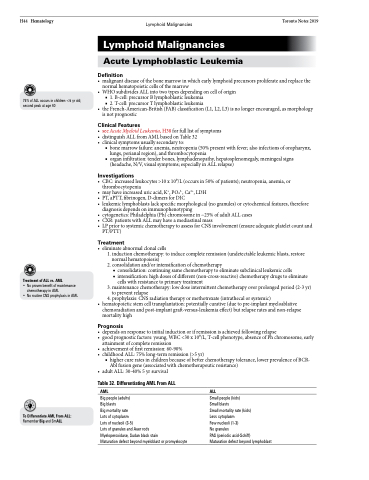Page 584 - TNFlipTest
P. 584
H44 Hematology
Lymphoid Malignancies Toronto Notes 2019 Lymphoid Malignancies
Acute Lymphoblastic Leukemia
Definition
• malignantdiseaseofthebonemarrowinwhichearlylymphoidprecursorsproliferateandreplacethe normal hematopoietic cells of the marrow
• WHOsubdividesALLintotwotypesdependingoncelloforigin ■ 1. B-cell: precursor B lymphoblastic leukemia
■ 2. T-cell: precursor T lymphoblastic leukemia
• theFrench-American-British(FAB)classification(L1,L2,L3)isnolongerencouraged,asmorphology is not prognostic
Clinical Features
• seeAcuteMyeloidLeukemia,H38forfulllistofsymptoms • distinguishALLfromAMLbasedonTable32
• clinicalsymptomsusuallysecondaryto:
■ bone marrow failure: anemia, neutropenia (50% present with fever; also infections of oropharynx, lungs, perianal region), and thrombocytopenia
■ organ infiltration: tender bones, lymphadenopathy, hepatosplenomegaly, meningeal signs (headache, N/V, visual symptoms; especially in ALL relapse)
Investigations
• CBC:increasedleukocytes>10x109/L(occursin50%ofpatients);neutropenia,anemia,or thrombocytopenia
• mayhaveincreaseduricacid,K+,PO43-,Ca2+,LDH
• PT,aPTT,fibrinogen,D-dimersforDIC
• leukemiclymphoblastslackspecificmorphological(nogranules)orcytochemicalfeatures,therefore
diagnosis depends on immunophenotyping
• cytogenetics:Philadelphia(Ph)chromosomein~25%ofadultALLcases
• CXR:patientswithALLmayhaveamediastinalmass
• LPpriortosystemicchemotherapytoassessforCNSinvolvement(ensureadequateplateletcountand
PT/PTT)
Treatment
• eliminateabnormalclonalcells
1. induction chemotherapy: to induce complete remission (undetectable leukemic blasts, restore
normal hematopoiesis)
2. consolidation and/or intensification of chemotherapy
◆ consolidation: continuing same chemotherapy to eliminate subclinical leukemic cells
◆ intensification: high doses of different (non-cross-reactive) chemotherapy drugs to eliminate
cells with resistance to primary treatment
3. maintenance chemotherapy: low dose intermittent chemotherapy over prolonged period (2-3 yr)
to prevent relapse
4. prophylaxis: CNS radiation therapy or methotrexate (intrathecal or systemic)
• hematopoieticstemcelltransplantation:potentiallycurative(duetopre-implantmyeloablative chemoradiation and post-implant graft-versus-leukemia effect) but relapse rates and non-relapse mortality high
Prognosis
• dependsonresponsetoinitialinductionorifremissionisachievedfollowingrelapse
• goodprognosticfactors:young,WBC<30x109/L,T-cellphenotype,absenceofPhchromosome,early
attainment of complete remission
• achievementoffirstremission:60-90%
• childhoodALL:75%long-termremission(>5yr)
■ higher cure rates in children because of better chemotherapy tolerance, lower prevalence of BCR- Abl fusion gene (associated with chemotherapeutic resistance)
75% of ALL occurs in children <6 yr old; second peak at age 40
Treatment of ALL vs. AML
• No proven benefit of maintenance chemotherapy in AML
• No routine CNS prophylaxis in AML
To Differentiate AML From ALL: Remember Big and SmALL
• adultALL:30-40%5yrsurvival
Table 32. Differentiating AML From ALL
AML
Big people (adults)
Big blasts
Big mortality rate
Lots of cytoplasm
Lots of nucleoli (3-5)
Lots of granules and Auer rods
Myeloperoxidase, Sudan black stain
Maturation defect beyond myeloblast or promyelocyte
ALL
Small people (kids)
Small blasts
Small mortality rate (kids)
Less cytoplasm
Few nucleoli (1-3)
No granules
PAS (periodic acid-Schiff)
Maturation defect beyond lymphoblast


